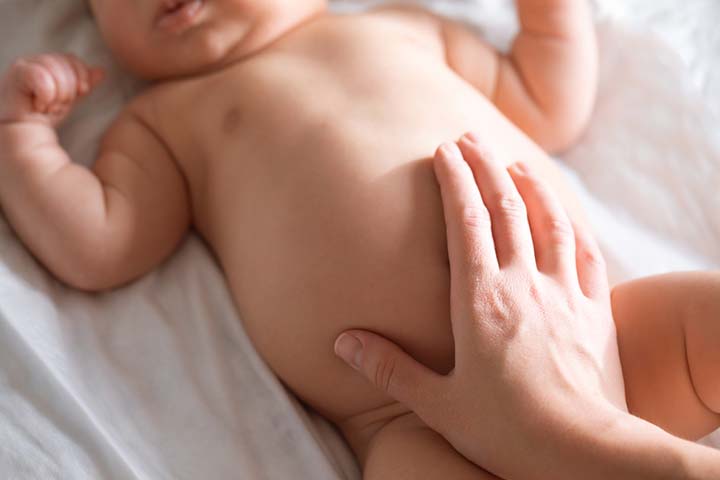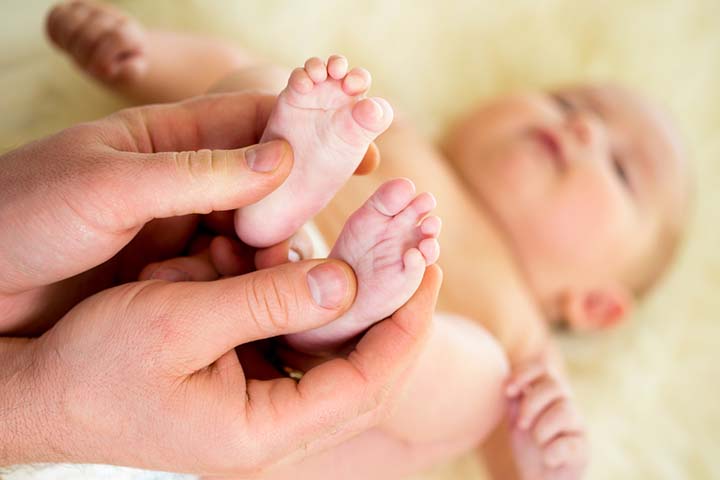
Babies start experiencing gas a few days or weeks after birth. It usually resolves by itself at six to seven months but may last for longer. A common cause of gassiness in babies is air swallowed while feeding or crying. For breastfed babies, the mother’s diet may also cause gassiness (1). In such cases, tummy massages can help release the trapped gas and relieve the baby.
Read on to learn about some baby massages for gas and other tips to manage gas in babies.
What Are The Symptoms Of Gas In Babies?
The symptoms that may indicate your infant is suffering from gas are as follows (1):
- Crying as if in pain
- Bloating
- Irritability and fussiness
- Passing gas or wind
 Quick fact
Quick factMassaging your baby’s tummy will help move the gas towards the bowel and relieve them of gas, colic, and constipation. You may use massage oil for proper movements and less resistance. Some daily massage techniques that may help soothe your baby are as follows (2):
1. Tummy massages
- Hands of a clock: Perform this massage in a circular motion. Make the bottom half of a semi-circle from your left to right with your right hand. Then make a full circle in clockwise motion with your left hand. Always perform this massage in clockwise direction with the left hand following the right.
- Fulling: Place your thumbs flat on your baby’s stomach and move them in a push-pull motion to the sides. Do two strokes above the naval, one stroke on either side moving out from the naval, and two strokes below the naval.
- Paddling: With the sides of your palms, make downward strokes on your baby’s stomach from the rib cage to the pelvis. Each hand should follow the other in a continuous motion.
- Moonwalking: Use your fingertips to walk across your baby’s abdomen from left to right. Do this above the naval area in a push-pull motion without poking.
- I Love You: With your palms, form an ‘I’ on the left side of the baby’s tummy. In the same way, draw an upside-down ‘L’ and ‘U,’ starting from your left to the right.
- Knees up: While holding your baby’s calves and knees gently, push both the legs together towards their tummy and hold it there for around five seconds. Repeat the process three to five times.
- Circular massage: If the baby’s tummy feels soft, massage it in a clockwise circular motion. If they start feeling unsettled with the massage, stop it and move to the next step. Do not massage the naval if the cord has not healed completely (3).
 Quick tip
Quick tip2. Foot massages
Reflexology is a therapy that effectively improves relaxation and wellbeing (4). Furthermore, certain studies on the effects of reflexology on babies suggest that they positively impact their health and wellbeing (5). Even so, more research is required for homogeneous results.
Nonetheless, after discussing with your healthcare provider or pediatrician, you could massage or rub the correct pressure points in your baby’s feet with moderate pressure to help relieve gas and colic.
3. Massages for colic
Colic is a condition where an otherwise healthy baby cries and fusses for unknown reasons for more than three hours (6). To date, the exact cause of colic in babies is unknown, but gas formation or food intolerance are sometimes considered as underlying reasons.
The massaging techniques used to relieve gas can help provide relief from colic as well.
What Are Some Other Tips For Managing Gas In Babies?
Other than massages, the following ways also help to manage gas in babies (7):
- Ensure less air is swallowed by your baby while feeding by slowing down the milk flow. Try different types of bottles or nipples to ensure this.
- To aid digestion and remove excess air from your baby’s system, burp your baby during and after their feeding session..
- Lay them flat on their back, hold their legs in your hands, and move them in a bicycling motion. Also, try giving them some tummy time to pressurize the excess gas out of the body.
- If certain foods in your diet may be causing gassiness in your breastfed baby, refrain from consuming them. However, consult your doctor before doing so to avoid discontinuing beneficial foods.
- If your baby is formula-fed, hold off on powdered formula and use ready-to-feed formula instead.
 Quick tip
Quick tipFrequently Asked Questions
1. How do I get my gassy baby to sleep?
Massages and other techniques, such as a gentle pat on the baby’s back or tummy massage, can help to relieve gas discomfort and thus help your baby sleep (1).
2. What are the pressure points to relieve gas in babies?
Large Intestine 4 (He Gu), Spleen 6 (San Yin Jiao), and Stomach 36 (Zu San Li) are some pressure points that may help relieve gas in babies (8).
3. Why is gas worse at night for babies?
According to a study, infantile colic caused by factors such as flatulence (gas) that is prevalent during the early night hours may be related to gut immaturity of the baby or breastfeeding (9).
4. Can my baby sleep through gas pains?
Babies can often sleep through gas pains, but if they are restless, they will cry constantly and will be unable to sleep.
It is not uncommon for babies to develop gas at a younger age. Gas can cause a lot of discomfort to babies and, therefore, the parents. Learning massage tricks may come in handy while you are desperately trying to console your crying baby in the middle of the night. Massages may also help calm your colicky baby and help in putting them to sleep with ease. However, you may seek help from your doctor or nurses at the hospital if you have any doubts about your newborn baby’s massage strokes. Be sure always to use a gentle touch when you massage your baby.
Infographic: Reflexology To Relieve Gas Pain In Babies
Each area of the foot is believed to correspond to a different organ in the body. This knowledge is utilized in foot reflexology to comfort babies experiencing abdominal issues. However, this technique should only be used under expert guidance and after consulting a pediatrician. Refer to the infographic to learn about the various reflexology points and when to massage them.

Illustration: Momjunction Design Team



